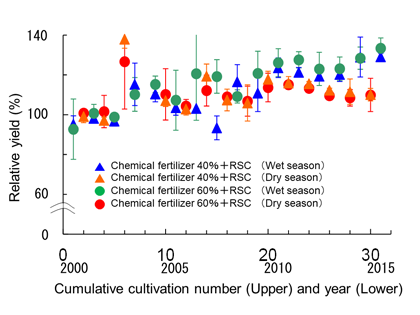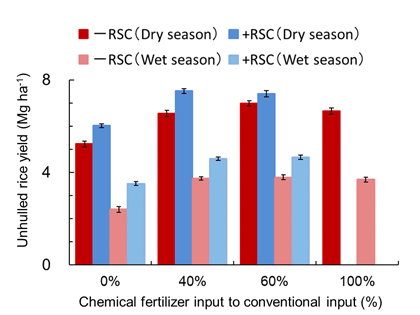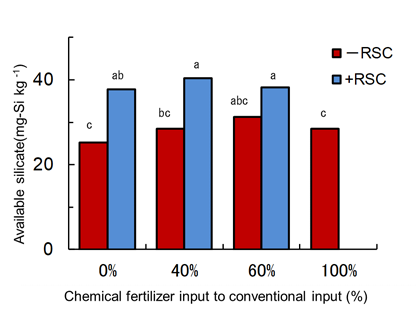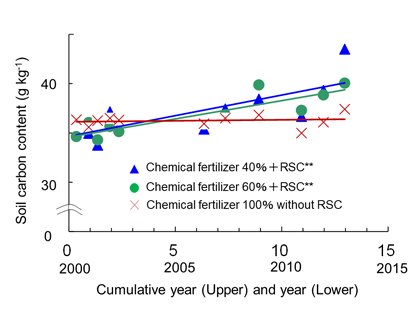Continuous application of rice straw compost increases rice yield and contributes to carbon sequestration in paddy fields in the Mekong Delta, Vietnam
Description
The Mekong Delta in Vietnam is the largest rice-producing region in Southeast Asia, contributing more than 20 million tons of rice annually. At present, many farmers in the Mekong Delta simply burn the rice straw in the field, incorporate it into the field after harvest, or ship a part of rice straw for mushroom cultivation. Continuous burning or removing of rice straw from the field may decrease soil organic matter content. Worse, the intensification of land use, combined with a reduced supply of nutrient-laden sediments caused by improved control of floodwater from the Mekong River, may exacerbate the decrease in soil fertility. We cultivated rice 31 times at twice a year (i.e., the dry season crop and the wet season crop) from 2000 to 2015, and evaluated the effects of continuous application of rice straw compost (RSC) on rice yield and total carbon in soil.
We applied RSC (6 Mg ha-1 as fresh weight for each crop) and several doses of chemical fertilizer to clarify their effects on rice yields and soil properties. We calculated the yields of treatments where RSC and moderate doses of chemical fertilizer (40% and 60% to a conventional dose) relative to those of the conventionally fertilized plots (i.e., with no added RSC) and analyzed their annual trends. The relative yields gradually increased from 2000 to 2010 (Fig. 1). The rice yields of the treatments where we applied RSC and moderate doses of chemical fertilizer (40% and 60% to a conventional dose) were 0.87 and 0.75 Mg ha-1 higher than that of the conventionally fertilized plots for the dry season, respectively, and 0.91 and 0.96 Mg ha-1 higher for the wet season in average from 2011 to 2015 (Fig. 2). Available silicon in soil samples from the surface layer (0-10 cm) in treatments with RSC was 10.4 mg kg-1 higher on average than that in treatments without RSC (Fig. 3). It seems that the increase of available silicon caused by RSC application contributed to the higher yields. Moreover, RSC application used in combination with moderate doses of chemical fertilizer increased total carbon in the soil at a rate of 356 to 401 kg C ha-1 year-1 (Fig. 4), indicating that tropical paddy fields can contribute to carbon sequestration.
The results indicate that continuous application of RSC increases rice yield in paddy fields in the Mekong Delta in Vietnam and that tropical paddy soil can contribute to the mitigation of global climate change by carbon sequestration. It is expected that our data will be harnessed by agricultural sectors and/or environmental sectors of the governments of Vietnam and other tropical Asian countries. Regarding the carbon sequestration function of tropical paddy soil, data from other tropical paddy fields needs to be incorporated. Although our RSC is fully fermented with low C/N ratio (less than 17.2), enhanced methane emission accompanied by organic matter input in paddy fields should be considered. Siliceous fertilizer can be an alternative to RSC because it also increases available silicon. However, we need to conduct a cost-benefit analysis to examine its feasibility.
Figure, table
-
Fig. 1. Annual changes in relative yields.
Bars mean standard deviation (n=3), Relative yield (%) = Yield of treatment / Yield of conventional treatment x 100, For the conventional treatment, chemical fertilizer was applied (as N-P2O5-K2O) without RSC at 80-30-30 (kg ha-1)in the wet season and 100-30-30 (kg ha-1)in the dry season. -
Fig. 2. Average yields for 5 crops (2011 to 2015).
Bars mean standard error (n=3), For the conventional treatment, chemical fertilizer was applied (as N-P2O5-K2O) without RSC at 80-30-30 (kg ha-1)in the wet season and 100-30-30 (kg ha-1)in the dry season. -
Fig. 3. Available silicon in the soil (0–10 cm) in the experimental paddy field following 25 seasons of rice cropping.
Data with the same letter does not differ significantly (Tukey p<0.05). The difference between the average of the +RSC (3 treatments) and average of the −RSC (4 treatments) was 10.4 mg kg-1. -
Fig. 4. Change in total carbon (g kg-1) in the soil (0–10 cm) in the experimental paddy.
** indicates that the slope was significantly different from 0 (p<0.01). The carbon sequestration ratios (kg C ha-1 year-1) in the text were calculated from the slopes and soil bulk density.
- Affiliation
-
Japan International Research Center for Agricultural Sciences Crop, Livestock and Environment Division
- Research project
- Program name
- Term of research
-
FY2017 (2011~2020)
- Responsible researcher
-
Watanabe Takeshi ( Crop, Livestock and Environment Division )
Luu Hong Man ( Cuulong Delta Rice Research Institute )
- ほか
- Publication, etc.
-
https://doi.org/10.6090/jarq.51.233
Watanabe T et al. (2017) JARQ, 51(3): 233-239
https://doi.org/10.6090/jarq.47.397Watanabe T et al. (2013) JARQ, 47(4): 397-404
- Japanese PDF
-
A4 402.28 KB
A3 350.29 KB
- English PDF
-
A4 297.49 KB
A3 298.37 KB
- Poster PDF
-
2017_A01_poster.pdf399.7 KB




